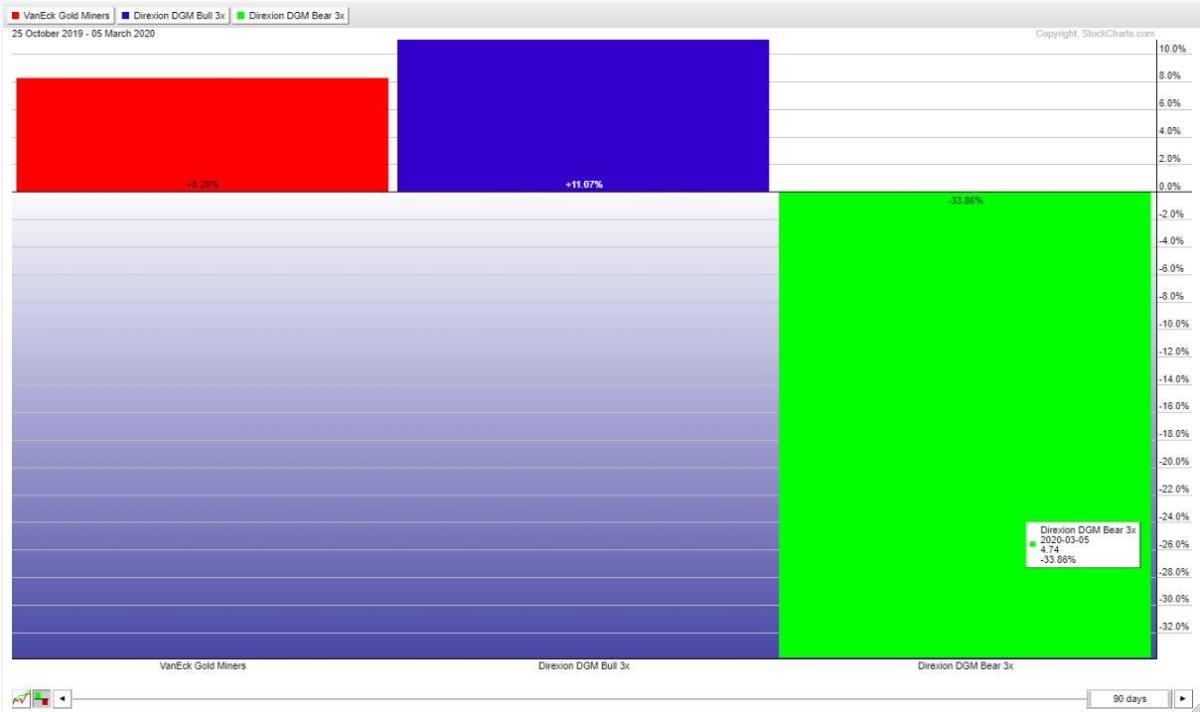Analyzing The Recent Volatility In Leveraged Semiconductor ETFs

Table of Contents
Understanding the Mechanics of Leveraged Semiconductor ETFs
Leveraged semiconductor ETFs offer investors amplified exposure to the semiconductor market, but it's crucial to understand how they work before investing.
Leverage and its Impact on Returns
Leveraged ETFs utilize derivatives and borrowing to achieve their leverage multiple, commonly 2x or 3x. This means a 10% increase in the underlying semiconductor index could translate to a 20% or 30% gain in a 2x or 3x leveraged ETF, respectively. However, the same leverage amplifies losses. A 10% drop in the underlying index would result in a 20% or 30% loss in the ETF.
- Daily Reset Mechanism: A key feature of leveraged ETFs is the daily reset. This means the leverage is applied daily, not cumulatively over longer periods. While this daily recalculation aims to track the index's daily performance, it can lead to significant deviations over time due to compounding effects.
- Compounding Effects Over Time: The daily reset can work against long-term investors. While a 10% gain followed by a 10% loss might seem to cancel each other out in a non-leveraged ETF, in a leveraged ETF, the compounding effect can lead to a net loss, known as "volatility drag."
- Increased Risk Profile: The amplified gains and losses inherent in leveraged ETFs significantly increase their risk profile. They are unsuitable for risk-averse investors or those with short-term investment horizons.
Underlying Asset Exposure
Leveraged semiconductor ETFs track specific indices or baskets of semiconductor stocks. Understanding the underlying assets is critical to assessing risk.
- Major Semiconductor Companies Represented: These ETFs typically hold a diversified portfolio of major semiconductor companies such as Intel, Nvidia, TSMC, Samsung, and Qualcomm. However, the specific weighting of each company varies across ETFs.
- Sector-Specific Risks: The semiconductor industry is susceptible to cyclical downturns and technological disruptions. Investing in a leveraged ETF concentrates this sector-specific risk.
- Impact of Weighting Schemes: The weighting scheme employed by the ETF (e.g., market-cap weighted, equal weighted) impacts the overall risk and return profile. Understanding these weighting schemes is crucial for assessing the ETF's performance.
Expense Ratios and Fees
Leveraged ETFs generally have higher expense ratios compared to their non-leveraged counterparts. These fees can significantly impact long-term returns.
- Importance of Considering Fees in Overall Returns: High expense ratios can eat into profits, particularly over extended holding periods. It's essential to compare the expense ratios of different leveraged semiconductor ETFs.
- Comparing Fees Across Different ETFs: Before investing, carefully examine the expense ratios and other fees associated with different leveraged semiconductor ETFs to identify the most cost-effective option.
Factors Contributing to Recent Volatility
The recent volatility in leveraged semiconductor ETFs stems from several interconnected factors.
Geopolitical Uncertainty
Geopolitical tensions, particularly US-China relations and trade disputes, have significantly impacted the semiconductor industry.
- Specific Examples of Geopolitical Events and Their Impact: Restrictions on technology exports and trade wars have created uncertainty and disrupted supply chains, impacting semiconductor prices and market sentiment.
- Analysis of Market Reactions: News related to geopolitical events often triggers significant price swings in semiconductor stocks and their corresponding ETFs.
Supply Chain Disruptions
Global supply chain bottlenecks and shortages of crucial semiconductor components have fueled volatility.
- Specific Disruptions and Their Consequences: Pandemic-related disruptions, natural disasters, and geopolitical events have created shortages, leading to higher prices and increased uncertainty.
- Ripple Effect on Prices: These shortages ripple through the entire semiconductor ecosystem, impacting production timelines and influencing market prices.
Interest Rate Hikes and Inflation
Rising interest rates and inflation affect investor sentiment towards growth stocks, like those in the semiconductor sector.
- Correlation Between Interest Rates and Stock Prices: Higher interest rates typically lead to lower valuations for growth stocks, as investors seek higher yields in fixed-income investments.
- Impact of Inflation on Semiconductor Demand: Inflation can impact consumer spending and corporate investment, potentially affecting the demand for semiconductors.
Earnings Reports and Company Performance
Individual company earnings reports can significantly influence the overall ETF performance and volatility.
- Significant Earnings Reports and Their Market Impact: Positive earnings surprises generally lead to price increases, while negative surprises can trigger significant sell-offs.
- Influence of Positive and Negative Surprises: Market reactions to earnings announcements are often swift and substantial, contributing to the volatility of leveraged semiconductor ETFs.
Managing Risk in Leveraged Semiconductor ETFs
Investing in leveraged semiconductor ETFs requires a careful approach to risk management.
Diversification Strategies
Diversifying your investment portfolio beyond a single leveraged semiconductor ETF is crucial to mitigate risk.
- Alternative Investment Options: Consider investing in broader market ETFs, other sector ETFs, or individual stocks to diversify your exposure.
- Importance of a Balanced Portfolio: A well-diversified portfolio helps reduce the overall volatility and risk associated with your investments.
Short-Term vs. Long-Term Investment Horizons
Leveraged ETFs are generally not suitable for short-term investments due to the amplified risks.
- Risks of Holding Leveraged ETFs Over Extended Periods: The daily reset mechanism and compounding effects can negatively impact returns over longer periods.
- Appropriate Investment Horizons: Leveraged ETFs are typically more suitable for sophisticated investors with a higher risk tolerance and a longer-term investment horizon.
Understanding Your Risk Tolerance
Before investing in leveraged semiconductor ETFs, honestly assess your risk tolerance.
- Self-Assessment: Determine your comfort level with potentially significant losses before committing any capital.
- Seeking Professional Financial Advice: Consider consulting a financial advisor to determine if leveraged semiconductor ETFs align with your investment goals and risk profile.
Conclusion
The recent volatility in leveraged semiconductor ETFs highlights the inherent risks associated with these investment vehicles. Leverage amplifies both gains and losses, making a thorough understanding of the underlying assets, market conditions, and potential risks crucial. Geopolitical uncertainty, supply chain disruptions, interest rate hikes, and individual company performance all contribute to this volatility. By understanding the intricacies of leveraged semiconductor ETFs and carefully managing risk through diversification and appropriate investment horizons, investors can navigate the volatility and potentially reap the rewards. Conduct thorough research before investing and consider seeking professional financial advice to ensure your investment aligns with your risk tolerance and long-term financial goals. Remember to carefully consider your risk tolerance before investing in leveraged semiconductor ETFs.

Featured Posts
-
 Onko Trumpin Politiikka Auttanut Byd Tae Ohittamaan Teslan
May 13, 2025
Onko Trumpin Politiikka Auttanut Byd Tae Ohittamaan Teslan
May 13, 2025 -
 Barnli I Lids Slavat Ofitsi Alno Se Vrakjaat Vo Premier Ligata
May 13, 2025
Barnli I Lids Slavat Ofitsi Alno Se Vrakjaat Vo Premier Ligata
May 13, 2025 -
 Analyzing The Hobbit The Battle Of The Five Armies Story Themes And Production
May 13, 2025
Analyzing The Hobbit The Battle Of The Five Armies Story Themes And Production
May 13, 2025 -
 The Gaza Hostage Crisis A Lingering Nightmare For Families
May 13, 2025
The Gaza Hostage Crisis A Lingering Nightmare For Families
May 13, 2025 -
 Tory Lanez Prison Stabbing Update On Singers Condition After Hospital Rush
May 13, 2025
Tory Lanez Prison Stabbing Update On Singers Condition After Hospital Rush
May 13, 2025
